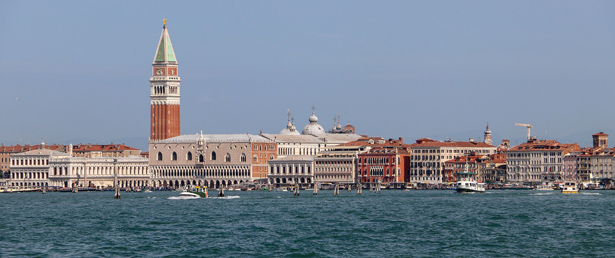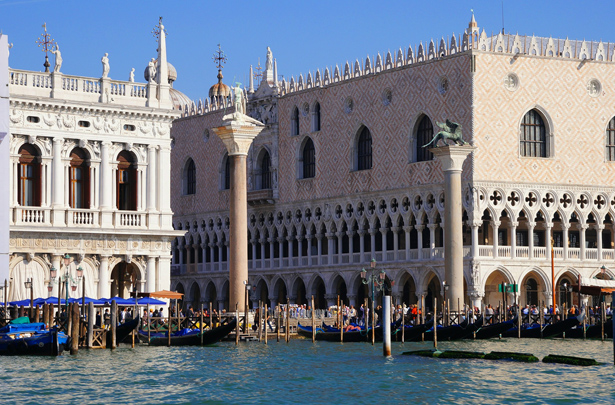Doge's Palace Tickets

TICKETS DOGE'S PALACE IN VENICE
(skip the line entrance)
PIAZZA SAN MARCO MUSEUM TICKET
RATES
Full ticket: 26,00 euro
Half price ticket: 14,00 euro
Children under 6 are free, no reservation.
The Doge's Palace is a palace built in Venetian Gothic style, and one of the main landmarks of the city of Venice. The palace was the residence of the Doge of Venice, the supreme authority of the
Republic of Venice, opening as a museum in 1923.
The Palace is the very symbol of Venice, in St. Mark’s Square, near to the famous Ponte dei Sospiri. A masterpiece of Gothic architecture, the Doge’s Palace is an impressive structure composed of layers of building elements and ornamentation, from its 14th and 15th century original foundations to the significant Renaissance and opulent Mannerist adjunctions.
OPENING TIMES
The Doge's Palace is opene every day except for the 25th Deceber and 1st January.
OPENING HOURS
01 April-31 October, the Palace is open from 8:30 am to 7:00 pm. Last entrance at 6:00 pm;
01 November-31 March, the Palace is open from 8:30 am to 5:30 pm. Last entrance at 4:30 pm.
PLEASE NOTE: this ticket is a cumulative ticket which allows a single entrance to each of the following museums: the Doge's Palace, the Correr Museum, the Biblioteca Marciana and the National Archaeological Museum.
Reservation includes 3,00 euro booking fees.
Tickets for the Doge's Palace are non-refundable nor cannot be modified in any way.
The Doge's Palace in Venice

The Doge’s Palace in Venice has always been considered an example of Venetian Gothic style. The Palace was built in 814 with numerous sighting towers. Later, the members of the Venetian council became so numerous that a new construction was necessary.
The structure od the Doge’s Palace gives a sense of lightness thanks to the porch located on the ground floor and the loggia located on the first floor, thus reversing the full and empty parts. The external facade is on two levels with columns and pointed arches pierced with large windows interrupted by the balcony.
The wing and the southern facade is the oldest part of the palace. At the corners, on the roof and on the balcony, there are statues representing the Lion of Saint Mark, the statue of Justice with her traditional symbols of sword and scales, the Arcangels Michael and Raphael, with Tobias, Noah, Adame and Eve dating back to the XIV century.
The Porta della Carta, also in Gothic style, represents the link between the Doge’s Palace and the Saint Mark's Basilica.
The Doge’s Palace consists mainly of three wings: the southern wing facing the lagoon, the western wing facing the square and the eastern wing facing the canal.
THE OUTSIDE AREA AND THE INDOOR SPACES OF THE DOGE’S PALACE
The internal courtyard of the Doge's Palace houses two of the most significant attractions: the Scala dei Giganti which was initially the official entrance to the Doge’s Palace. It was erected between 1483 and 1491following the designs of Antonio Rizzo. The name of the staircase is due to the two marble statues of Jacopo Sansovino depicting Mars and Neptune representing the power of Venice on the mainland (reference to Mars) and the sea power (reference to Neptune).
The second attraction that captures the visitor's attention is the Arco Foscari, also built by Antonio Rizzo.
The Doge’s Palace hosted the private apartments of the Doge and was the centre of Venetian political power too. Famous artists such as Tintoretto, Titian and Paolo Veronese decorated the sumptuous rooms.
Inside the Four Doors Room you can admire ", the famous work of Titian "The Doge Marino Grimani davanti alla fede”. The Council of Ten commissioned the painting in 1555. The canvas remained for many years in the painter's workshop and some years later his death was completed by the artist Marco Vecellio and his pupil.
Titian represents the Doge with his armour, emphasizing his role as defender of the faith.
Continuing the visit inside the Doge’s Palace we arrive in the Antechamber to the Hall of the Full Collegewhose walls were frescoed with four panels by Tintoretto and decorated with a painting by Paolo Veronese. Then we arrive in the The Chamber of the Council of Ten where we find the ceilings carved and decorated by Paolo Veronese. Finally, the passge of Great Council, where we can see a sumptuous fresco of Guariento, unfortunately ruined by a fire in 1577.
At the end of the visit, we reach the Hall of The Great Council, where there are seventy-six portraits of Doges.
Getting down from the lodge it is possible to visit the Old Prisons, called “wells”. At a first glance, you see the narrow cells, wet and gloomy. Crossing the Ponte dei Sospiri (Bridge of Sighs) you can get to the New Prisons built in the second half of the 500 along with the torture rooms.
This area is accessible booking the Secret Itineraries.
THE NEW PRISONS: THE BRIDGE OF SIGHS
The Bridge of Sighs is one of the most famous bridges in Venice, known without doubt from all over the world.
The architect Antonio Conti built it in the XVIIth century, to connect the Doge’s Palace to the New Prisons. Antonio Da Ponte projected the New Prisons around 1580 in a new building in order to replace the Old Prisons located inside the Doge’s Palace.
The bridge is a great example of Baroque style, it is made of white limestone, a microcrystalline calcareous rock with very low porosity.
The bridge hides two corridors separated by a wall that connects the prisons: a corridor leads to to the Chamber of the Magistrato alle Leggi, located on the main floor of the Doge’s Palace. The other corridor links the prisons to the Chamber of the State Advocacies and the Parlatorio.
The bridge was designed by the architect Conti to ensure maximum security against any attempted escape from the prisoners. The bridge was in fact used to move the prisoners from prison rooms to the Chamber of the Magistrato alle Leggi, where they had to be tried.
According to popular tradition, the Bridge of Sighs would have this name because inside it passed prisoners awaiting trial, who could observe the lagoon and the panorama, sighing for the long, perhaps infinite, detention that awaited them in the cells of the Serenissima (the ancient name of Republic of Venice).
The most inhospitable cells were called the Pozzi, eighteen dark and small rooms covered in wood, communicating only with gloomy corridors. The conditions of life were undoubtedly critical: food was scarce, the air was heavy and unbreathable and the rooms were overcrowded. The cells, intended for prisoners from the poorer classes, were placed below the water level and therefore humid and unhealthy.
The most high-ranking prisoners were relegated to the Piombi, which were however, due to the lead coating on the walls, very hot in the summer months and cold in the winter. Here some prison cells were set up in advance for political crimes involving non-long sentences for non-serious crimes. The seven cells were obtained by subdividing the space of the attic with wooden partitions, nailed and reinforced by large sheets of iron.
The New Prisons certainly represent, for their epoch, one of the first examples in Europe of a block-type, single-unit construction site, destined to be a state prison.
How to choose the correct ticket for Doge's Palace and Correr Museum
Half price ticket: people over 65 years old, students with student card from 15 to 25 years of age, children under 14 years old.
Free ticket (no reservation)
I.C.O.M. members, Venice citizens children under 6 years old (no reservation is required).









